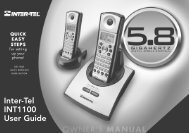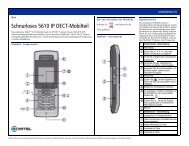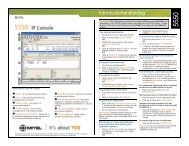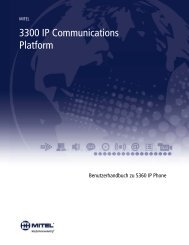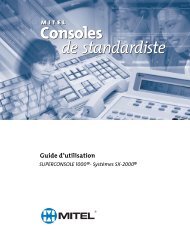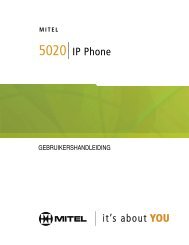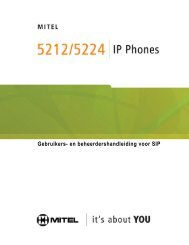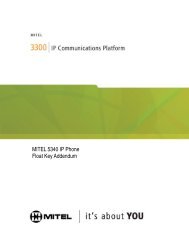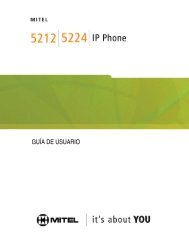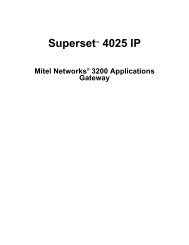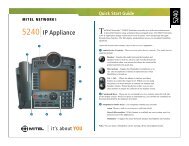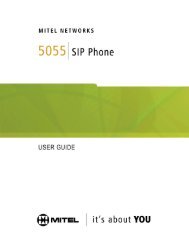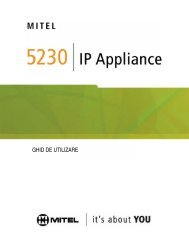Mitel 5624 Wireless Handset User Guide - Mitel Edocs
Mitel 5624 Wireless Handset User Guide - Mitel Edocs
Mitel 5624 Wireless Handset User Guide - Mitel Edocs
You also want an ePaper? Increase the reach of your titles
YUMPU automatically turns print PDFs into web optimized ePapers that Google loves.
Contacting Emergency Services<br />
About Your Phone<br />
This handset, like any wireless phone, communicates using radio signals. As with any wireless<br />
phone, you may not be able to establish a connection under all conditions; therefore, you should<br />
not rely solely on a wireless telephone for essential, emergency communication. The key lock<br />
feature disables the handset keypad and prevents the accidental dialing of numbers that may<br />
result in nuisance calls. It also prevents accidental calls to emergency services numbers like<br />
911, 999, or 112.<br />
To disable the key lock feature, press the key and then press the Yes softkey.<br />
Currently, mobile IP phones do not support Enhanced 911 (E911) operation. If emergency<br />
services are required, it is necessary to keep the system administrator and location database<br />
up-to-date.<br />
Tips for your Comfort and Safety<br />
Don't Cradle the <strong>Handset</strong>!<br />
Prolonged use of the handset can lead to neck, shoulder, or back discomfort, especially if you<br />
cradle the handset between your ear and shoulder. If you use your phone a lot, you may find<br />
it more comfortable to use a headset. See the section on headset usage elsewhere in this guide<br />
for more information.<br />
Protect your Hearing<br />
Your phone has a control for adjusting the volume of the handset receiver or headset. Because<br />
continuous exposure to loud sounds can contribute to hearing loss, keep the volume at a<br />
moderate level.<br />
Frequency Range<br />
The handset is a radio transmitter and receiver. When it is on, it receives and sends out radio<br />
frequency (RF) energy. The handset operates on different frequency ranges depending on<br />
market and employs commonly used modulation techniques:<br />
EU b/g: 2400–2483.5 MHz (Ch 1–13) and<br />
a: 5150–5350 MHz (Ch 36, 40, 44, 48, 52, 56, 60,<br />
64), 5470–5710 MHz (Ch 100, 104, 108, 112,<br />
116, 120, 124, 128, 132, 136, 140)<br />
USA/CAN b/g: 2400–2483.5 MHz (Ch 1–11) and<br />
a: 5150–5350 MHz (Ch 36, 40, 44, 48, 52, 56, 60,<br />
64), 5470–5710 MHz (Ch 100, 104, 108, 112,<br />
116, 120, 124, 128, 132, 136, 140), 5725–5875<br />
(Ch 149, 153, 157, 161, 165)<br />
Note: DFS channels should be avoided as Mobile devices are prevented from using<br />
these channels without a period of listening to ensure radar avoidance. This listening<br />
time causes delays in the ability to communicate with the WiFi infrastructure and therefore<br />
are not suitable for voice. Instead configure the PP to use UNII-1 channels.<br />
5



